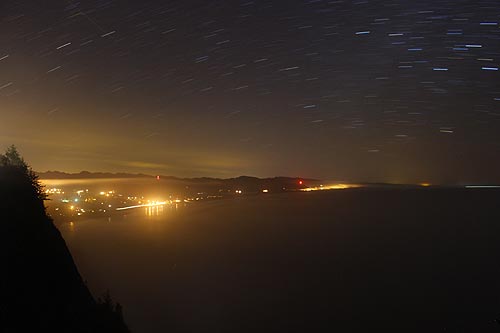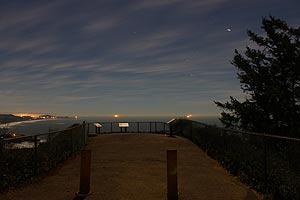 |
Stargazing from an Oregon Coast Perspective - Tips, Discoveries
Published 02/23/2011

(Manzanita, Oregon) – Part 1 in this two-part story.
With its windy conditions and often cloudy skies, it’s not what people normally think about when considering a spot to set up a telescope and gaze at the universe. But the Oregon coast is not windy every day, and the clouds do disappear – with more frequency than you may realize. And when these conditions happen at night, the possibilities for stargazing and astronomy are, well, out of this world (above: stunning star trails at the overlooks above Manzanita).
 |
| The overlooks at Manzanita during the daytime. |
When clear conditions present themselves, and the wind dies down, the nighttime skies are much clearer than inland spots like Portland, Seattle or Eugene because of less pollution and no light interference. This is why the coastline is an exceptional bet for watching meteor showers – really any time of the year – because you can see so much. It doesn’t take an actual meteor shower event for you spot some amazing shooting stars.
The fact is, shooting stars hit the Earth’s atmosphere all the time.
“We get around 20 million a day, 24/7/365 - on average,” said Jim Todd, astronomer with OMSI in Portland – referring to 24 hours a day, seven days a week and 365 days a year. It’s a shocking statistic indeed. But, he adds, it’s not a constant rate: this fluctuates. And we don’t see all of them.
These meteors that happen outside of the known, regular meteor shower periods are called sporadic meteors.
 |
| More nightscapes above Manzanita |
“Go out on a dark night away from street lights and you'll see more,” Todd said. “Faint ones don't show up with city lights around. You might see six or more in an hour, sometimes a lot more, sometimes – a bad night.”
A case in point: the overlooks at Manzanita. These are exceptional spots for checking out the stars at night. Most of this is because you are cut off from any light interference whatsoever, as there are no street lights nearby, and the lights of Manzanita below – while exceptionally pretty – don’t mess up the sky at all, except for perhaps immediately east of the village.
Another factor is the height of the overlooks, which helps cut off light even more. Other awesome spots to get away from light pollution on the coast are Gleneden Beach near Lincoln City (especially the state park), the overlooks just north and south of Depoe Bay, Cape Foulweather, the overlooks at Silver Point just south of Cannon Beach, Arch Cape, and parts of Pacific City, Oceanside, Rockaway Beach and plenty of beaches and overlooks between Florence and Yachats.
 |
| Cape Foulweather at night: a bright moon does interfere with the clarity of stars, but it's still awesome up here |
“No light is the main factor for being able to see the shooting stars and other celestial objects,” Todd said. “Plus, Manzanita is on the coast and there are no light pollution sources to the west and minimal to the east directions.”
With the overlooks of Manzanita some 600 feet above sea level, does this help in seeing celestial stuff? The spot is remarkable for spotting shooting stars, but Todd said no to this idea, and hinted about the atmospheric conditions that do like to get in the way on the coast.
“Not so much the altitude makes a difference but how transparent the skies are in terms of amount of moisture or humidity present,” Todd said. “Viewers would see more stars in the dessert than from the ocean because of the transparencies of the sky.”
 |
| Newport at night |
So while not the most ideal place in Oregon to see things bouncing around the night sky, the coast is pretty awesome – but again, given the right conditions.
Todd offers tips on spotting these.
“It's better in the early morning well after midnight, but you can see them any time when it's dark enough,” Todd said.
There will be a part 2 to this article, pointing out some interesting facts about star trails and other unusual things you can catch while photographing the sky.
More About Oregon Coast hotels, lodging.....
More About Oregon Coast Restaurants, Dining.....
 |
 |
 |
LATEST OREGON COAST NEWS STORIES
Whale Body Parts Found on Oregon Coast - Two Whales Strand on Washington Coast |
Back to Oregon Coast
Contact Advertise on BeachConnection.net
Secrets of the Season |
Unusual Travel Articles TravelParanormal.com allows you to submit your own creepy tale or debunk one - or see up-to-the-minute news headlines about travel and the paranormal. News Headlines from All Over Oregon Need to scan Oregon headlines? Constantly updated news from all over Oregon: a comprehensive, up-to-the-minute display of news headlines from a variety of media |






































